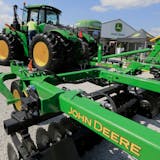The United Auto Workers union expanded its strike from three to 38 locations across 20 states, officials announced Friday, including a couple of sites in the Twin Cities metro area.
The strike expansion, which means another 5,600 auto workers will be on the picket lines, is a significant escalation and worrisome to car dealers, parts suppliers and auto transportation business owners in Minnesota and elsewhere in the nation.
The move comes one week after 13,000 UAW members went on a partial strike, shutting down one factory from each of the Big Three automakers: General Motors, Chrysler owner Stellantis and Ford. Friday afternoon, UAW President Shawn Fain called for the strike to involve additional GM and Stellantis parts distribution locations, including a Stellantis facility in Plymouth and a GM facility in Hudson, Wis.
The UAW did not include more Ford locations, given the union felt it made "real progress" this week during bargaining discussions with the company, Fain said in a statement posted online Friday morning.
The 38 new locations picked Friday "were a surprise," Twin City Die Castings CEO Todd Olsonsaid in an email.
"[The new strike sites] are all part distribution centers and warehouses. Almost all, if not all, of the parts go to dealers who service vehicles," said Olson, who makes metal die castings for the big automakers. "It will impact the dealers and consumers more than the Big Three. It shouldn't really impact their ability to sell cars, but fairly soon, it will impact the ability to repair them."
It's already being felt at Luther Hudson Chevrolet GMC.
"The [GMC] parts warehouse is in Hudson, here, [the workers] all walked out," service representative Jack Johnson said. "So all the dealers won't be getting parts for a while until they figure this out."



